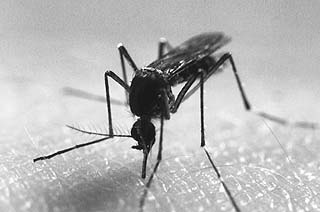
Surveys
DJC.COM
July 17, 2003
Controlling mosquitos and the environment
Eden Advanced Pest Technologies

Marlowe
|
While it is prudent to treat for mosquitoes to protect the public from this menace, it is equally prudent to avoid undue harm to the environment. The fact that the most crucial treatment for mosquito control is made to water, further complicates the issue.
Ecological and environmental concerns emphasize the need for integrated mosquito control programs. An integrated approach to mosquito control involves accurate and complete assessment of the problem and employment of control and management practices that are best suited for a specific situation. The selected means of control may include any one or a combination of physical, biological or chemical techniques.
West Nile virus

Photo courtesy of Eden Advanced Pest Technologies
Mosquitos can carry the West Nile virus.
|
According to the Centers for Disease Control and Prevention (CDC), West Nile virus has been found in 43 states, reaching Washington state last year, and is responsible for over 4,000 human cases resulting in 284 deaths.
The virus is actually a disease of birds. Humans become infected when bitten by a mosquito that had been feeding on an infected bird. Over 140 species of birds have been afflicted and it is estimated by the CDC that over 1 million birds have died. Even the equine population faces a serious threat, with West Nile virus spreading west and affecting horses at a rapid rate (11,000 cases through December 2002).
Surveillance
Surveillance is the first critical step where possible mosquito breeding sites are identified and mapped. These sites are then checked regularly during mosquito season (April through October) for the presence of mosquito larvae and pupae.
Only after threshold levels are reached would treatments be made. Thresholds are determined so that mosquitoes will not get out of hand before treatment is made, but allows for natural, environmental controls such as predators to work first.
Proper surveillance allows for treatments to be made only when necessary and targeted to only the breeding sites that are actually producing adult mosquitoes.
| The scoop on skeeters |
|
|
Larval control
Mosquito control should focus on the larval stage since treatment at this time is truly preventative. This state in the mosquito life cycle is confined to water.
Mosquito larvae are generally more vulnerable to control measures than adults. Once mosquitoes develop into adults they are harder to control since they will leave their breeding sites in search of blood meals.
The window of opportunity is short for controlling this life-phase of the developing mosquito. In ideal conditions the development of a mosquito brood can take place in a week to 10 days. Through larval control, 90-95 percent control can often be achieved, which reduces the need to perform fogging operations over large areas to control adult mosquitoes.
Larva mosquito may be controlled by water level management such as draining, filling or installing fountains. Where these methods are not practical or desirable (wetlands are valuable resources and should not be eliminated), larvicides may be used effectively.
A combination of larvicides and the natural predator population can make a significant dent in the development of mosquito populations without negatively impacting the environment.
Three tools are commonly used for this purpose. They are:
- Bacillus thuringiensis israelensis or Bti. Bti is a bacterium that acts as a stomach poison. It is highly selective for mosquitoes and has no effect on a vast array of other aquatic organisms. Bti has been extensively studied for effects on non-target organisms and environmental consequences with no reported adverse effects.
- Methoprene. This product mimics a natural juvenile hormone, keeping immature insects from maturing into adults. Results from field studies involving methoprene have shown that it has no lasting adverse effects on populations of invertebrates or other non-target aquatic organisms when used according to label instructions for mosquito control. Methoprene is not persistent in the environment.
- Surface films. This product disrupts the surface tension of the water, which inhibits the ability of mosquito larvae and pupae to attach to the surface not allowing them to breath, or emerge from the pupal stage.
In Washington state, the Department of Ecology now requires a permit for any one who is going to make mosquito larvicide applications to waters of the state. Also, applicators are required to obtain the correct license or licenses before any applications are made.
Adult mosquito control
| Do your part |
The National Pest Management Association recommends that every homeowner and business owner do their part to control mosquitoes by:
|
The purpose of adult mosquito control is to reduce the number of biting female mosquitoes to a level where they are no longer a nuisance or a disease threat to humans.
The use of ultra low volumes (ULV) of insecticides to kill adult mosquitoes are done when survey methods or disease monitoring indicate the need for chemical control. ULV applications are most effective on flying mosquitoes.
The equipment and materials now being used have come a long way from the days of noisy clouds of fog spewing from the back of old pickup trucks. Today’s applications are made with sophisticated computerized equipment that controls exactly the amount and droplet size of the material to effectively target mosquitoes while minimizing the impact on the environment. The small droplets are designed to impinge on the fine hairs on the mosquito body. Flying insects larger than a mosquito, which may encounter a droplet, do not usually receive a lethal dose. Also, insects not flying at the time mosquito applications are made are not affected by these applications due to the short duration (a few hours) that these products persist.
Public health
Dealing with West Nile virus will require everyone’s involvement. Citizens should not just depend on municipalities to address mosquitoes, they should be aware of potential mosquito breeding grounds around their household and should take proper precautions against being bitten.
Homeowners may want to hire a licensed pest management professional to help with identification and treatment of mosquito production sources and treatment of adult resting areas.
The newest technology and equipment allows for a targeted, environmentally sensible approach.
To learn more about safe mosquito control offered by Eden Advanced Pest Technologies, call (800) 401-9935 or visit www.edenpest.com. For more information about the West Nile virus, contact your state or local health department or visit www.cdc.gov.
Jack Marlowe is president of Olympia-based Eden Advanced Pest Technologies. He has sat on a variety of integrated pest management committees and written programs for schools, colleges, government agencies and numerous commercial facilities.
Other Stories:
- Battle over keeping dams rages on
- What’s your vision for Seattle’s future?
- Hat Island gets a drink from the sea
- Foss Waterway cleanup kicks into high gear
- Reclaimed water — a ‘new’ water supply
- LOTT dives into reclaimed water
- Clean air: saving our competitive advantage
- Europe points the way to sustainability
- Old maps handy for site investigations
- Planning for an environmental emergency
- Engineered logjams: salvation for salmon
- Pierce County maps where its rivers move
- Be prepared with a spill management plan
- Development can be beneficial to wetlands
- Check out properties with microbial surveys
- Charting a sustainable course for the Sound
- Water rights no longer a hidden asset
- The economics of sustainability
- Laying the path for responsible education
- Squeezing more out of renewable energy
- Beavers back in force in the Seattle area
- Our future: no time or resources to waste
- Port Townsend dock promotes fish habitat
- Brownfields program is here to stay
- Master Builders teaches green homebuilding
- Sculpting a park out of a brownfield
- A salmon-friendly solution on the Snake
Copyright ©2009 Seattle Daily Journal and DJC.COM.
Comments? Questions? Contact us.